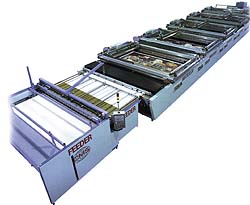Articles
Published
24 years agoon

Most magazines you read are printed in a multicolor format. So are many of the movie posters at your local video shop and display graphics you see at the grocery store. In many cases, these items were offset printed in multiple colors. To achieve these prints, substrates simply went into one end of the offset press and came out of the other end printed in four-color process. Some prints were even treated to a highlight spot color or glossy clearcoat as part of the process.
In contrast, many of the multicolor screen-printed displays and banners you encounter at sporting events, retail outlets, and fast food chains were printed one color at a time, with each sheet repeating a print-cure-stack routine several times until the job was completed. No matter how fast you screen print in this manner, it is slow compared to the speed of offset printing–or multicolor inline screen printing.
The days of laborious multicolor screen printing seem to be numbered, especially with the increasing demand for inline screen-printing systems to produce medium- and large-format graphics. Today, automation and speed are not only characteristic of the offset printing process; they are now being applied to screen printing as well, and shops that incorporate multicolor inline printing systems (Figure 1) are reaping the benefits.
Background
The idea of automated multicolor printing was inspired by the textile industry about 25 years ago, when multicolor presses were developed to print all colors in one printing line. Then roughly 15 years ago, graphic carousel presses became popular for the vinyl binder industry.
At the same time, screen printers who did larger-format graphics continued to print multiple colors with single-color presses. Not only was this time consuming, it also led to severe substrate shrinkage problems between colors, particularly with thin paper and plastic substrates. This made tight registration a challenge and process-color printing virtually impossible. Printers wanted to stack the sheets once and not have to deal with temperature and humidity changes that affected partially printed sheets.
So, more than a decade ago, multicolor inline screen-printing systems began to make their appearance. For shops involved in point-of-purchase and display graphics screen printing, these systems introduced a new way to improve printing quality and productivity and enhanced the competitive position of the screen-printing process.
Today, at least eight manufacturers produce inline multicolor screen-printing systems, and the installed base worldwide consists of approximately 150-200 printing lines–excluding web and carousel graphics presses. Growth in large-format inline multicolor graphics is exponential, and equipment suppliers are getting more and more requests for multi-color inline printing equipment.
Why get into multicolor printing?
“I want to do four-color process,” is what equipment suppliers hear from graphics printers. If this is your goal as well, your company needs to determine its printing needs and carefully study machine options before taking the big plunge into multicolor inline equipment. For the record, five-color inline systems tend to be the most popular configuration, followed by two-color lines for those whose pockets aren’t quite so deep.
Investing in a multicolor inline printing system is a big step for a typical screen-printing operation. You can expect to spend from about $900,000 to $2 million for a five-color line. While the return on your investment can be as fast as six months, billable time on these presses varies with location and market conditions. For example, a company in Sweden may get $1200/hr for its inline presses, while a printer on the West Coast of the US may only earn $850/hr from the same system. The main point is this: Before you invest in a multicolor system, make sure you’ll have enough orders to keep it busy all the time.
Some of the benefits multicolor presses deliver include the following:
Speed A typical, single-color, large-format press might run 300 impressions/hr, while a smaller single-color press could produce 600/hr. By lining these presses up to form a four-color inline production system, production rates could jump to 1200 impressions/hr on large-format jobs and 2400 on small-format work. This production speed is the primary reason people move into multicolor printing.
Proofing time Speed again comes into play in proofing time. Most customers want to see a proof before a job is fully run. If it’s a process-color job and you print it on a single-color press, this means you have to set up and tear down the machine four times just for a proof. With an inline system, you set up the four presses once, print proofs quickly, and if the job is approved immediately, avoid tearing the machines down until the production run is complete.
Smaller footprints A multicolor system is much more compact than an equivalent number of standalone presses to handle the same number of colors, which means a multicolor system can help conserve floor space in your shop. The days of monster-sized presses with conventional ovens taking up 60-80 ft of floor space are also disappearing as more and more printers shift to UV inks. Multicolor systems for printing UV inks feature inline curing between colors, which makes a standalone oven unnecessary.
Labor savings If labor reduction is your goal, an inline system may be the answer. Running four standalone presses to produce a job might require two operators per machine or a total of eight workers. But today, a large-format, five-color inline unit can run with as few as two people–the same number it might take to run one single-color large-format press. The ability to quadruple output while cutting labor by 75% is another attraction of these systems and one of easiest ways to justify their expense.
Before inline systems were introduced, a typical multicolor screen-printing setup involved lining up two or more single-color presses, and placing a worker between each machine to transport the printed sheet from press to press. The challenge for inline press manufacturers was to find a way to transport the sheet automatically between stations. Today’s selection of flatbed or cylinder inline systems can be defined by the type of transport system they employ, which can be one of three basic varieties.
Gripper system On most flatbed inline systems, a set of grippers grabs the sheet and pulls it from station to station. At the front end of the system, an operator or automatic feeder positions each sheet to be picked up by the grippers. Once the grippers take hold of the sheet, they pull it forward from one print station to the next, pausing at each station while a synchronized vacuum table draws the sheet down during the print stroke. The grippers are pin registered at each print station and maintain proper sheet alignment through printing and curing.
Moving platen In this type of flatbed multicolor line, the entire platen or print bed moves on a set of chains through each phase of the printing process. The platen uses vacuum pressure to draw the sheet down before the first color is printed and does not release the sheet until after the final color is printed and cured. The platen’s arrival at each station triggers the print cycle.
Drive belt Multicolor cylinder-press lines employ drive belts. The belts are slaved to the print units with servo motors, and, after a sheet is printed, the belts transport the sheet through the drying unit to the preregistration station of the next print unit.
The preregistration station moves the sheets into position for final registration, where grippers and guides precisely align the sheet for pickup by a cylindrical printing surface. Sheets are held in position on the cylinder with vacuum pressure as it rotates beneath a synchronized screen and stationary squeegee during the print stroke (Figure 2). This process repeats at each print station, and when printing is complete, belts transport the sheets to a stacker.
Cylinder presses provide very tight registration and the highest speeds of any screen-printing system. Thanks to their precise registration method, they tend to support higher-resolution halftones than flatbed inline presses.
What to purchase
If you’ve decided that an inline system is right for your shop, it’s time to decide how many stations you need. In the long run, a five-color model will probably offer the greatest flexibility. Five-color systems allow you to apply an extra spot color or protective coating as another step of the inline printing process. This saves you the time and expense of printing the additional color or applying a protective coating in a separate pass through the system. However, you can also buy a less expensive two-color line and expand it later.
Inline printing systems come in many configurations. Some incorporate inline UV-curing units (Figure 3) or come bundled with a conventional drying section at the end for non-UV applications. Conventional drying can, however, make for an extremely long line. So the vast majority of inline systems currently available are designed for printing UV inks. Note that the intermediate curing sections, which can be as narrow as 3 ft wide, impart a low-level cure between colors to avoid overcuring the inks.
Feeders and stackers can also be part of the package. Some multicolor lines allow operators to simply load the feeding mechanism, then the machines feed, print, dry, and stack automatically. In some cases, however, the nature of the material being printed may require hand loading and stacking. Also note that flatbed systems typically support thicker substrates–on cylinder presses, the substrate must be thin and flexible to wrap around the printing cylinder.
It is important to know what types of materials you will be running so you can specify the correct machine for the application. Also make sure to look for a machine that is flexible enough to handle the same variety of materials you typically print.
Inline systems are available in broad range of sizes. For common display applications, suitable systems come with printing sizes of 28 x 40 in. and range up to 72 x 144 in. Most inline systems are modular, allowing you to plan for future expansions and upgrades, such as extra print or curing stations.
Get inline
Screen printers are increasingly turning to automation in order to remain competitive. And the growing use of multicolor inline printing systems shows that speed and improved print quality are priorities for shops that want to remain successful. With inline printing, orders that used to take days or weeks to print can now be completed in a single day, proofing is faster and easier than ever, labor costs are lower, and floor space is much less critical. In light of the challenges screen printers face from offset and the growing presence of digital graphics, multicolor inline screen presses are a logical step in remaining competitive.
About the author
H. Sean Fremon is a national product manager for Ernst W. Dorn Co., Inc., Gardena, CA, a distributor of graphics screen-printing equipment. Fremon has a degree in communications from California State University and spent four years as an Air Force journalist. He has been working in the screen-printing and allied industries for the past several years and can be contacted at sean@fremon.com or in Akron, OH at 330-899-9110.

Subscribe

Magazine
Get the most important news
and business ideas from Screenprinting Magazine.
Most Popular
-

 Art, Ad, or Alchemy1 month ago
Art, Ad, or Alchemy1 month agoF&I Printing Is Everywhere!
-

 Case Studies1 month ago
Case Studies1 month agoHigh-Density Inks Help Specialty Printing Take Center Stage
-

 Andy MacDougall1 month ago
Andy MacDougall1 month agoFunctional and Industrial Printing is EVERYWHERE!
-

 Editor's Note1 week ago
Editor's Note1 week agoLivin’ the High Life
-

 Columns2 weeks ago
Columns2 weeks ago8 Marketing Mistakes Not to Make When Promoting Your Screen Printing Services Online
-

 Thomas Trimingham2 months ago
Thomas Trimingham2 months ago“Magic” Marketing for Screen Printing Shops
-

 Marshall Atkinson1 week ago
Marshall Atkinson1 week agoHow to Create a Winning Culture in Your Screen-Printing Business
-

 Press Releases2 months ago
Press Releases2 months agoBig Frog Custom T-Shirts & More of Round Rock Celebrates Grand Opening






